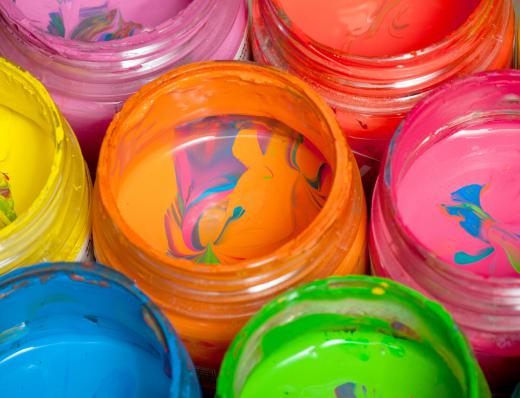What is Acetic Acid?
 Mary McMahon
Mary McMahon
Acetic acid is a weak acid which is probably most famous for being the primary acid in vinegar. In fact, acetic acid has a wide range of uses beyond sprinkling on salads, and it is produced in large volumes all over the world. People have been working with this acid in a number of contexts for centuries, with acetic acid being one of the substances explored by alchemists, the predecessors of modern chemists.
This organic acid can be prepared in varying concentrations. In pure form, it is known as glacial acetic acid because it crystallizes in cool temperatures. This form of the acid is extremely corrosive and can be hazardous to work with, requiring special precautions for protection. Vinegar, by contrast, usually has an acetic acid concentration of around five percent.

There are a number of ways in which this acid can be prepared. One method is bacterial fermentation, the technique used to make vinegars, in which the acid is generated as a byproduct of bacterial digestion. Other techniques involve producing chemical reactions which result in this acid, as is done in commercial manufacture of this product. When the acid is destined for use in food, however, it is usually produced biologically because this is often required for food labeling reasons.

This clear, colorless acid has a distinctive sour taste, although tasting it is not recommended unless it is clearly labeled as fit for human consumption. It also has a strong, sharp odor which is familiar to many people because it smells like vinegar. Or, rather, vinegar smells like this acid. In food preparation, it can be used as a flavoring, with the sharp taste being desirable in some foods, and also as a food preservative. The acid inhibits bacterial growth, keeping food safe from contamination. The historic use of vinegar as a food preservative has created an acquired taste in some cultures for the distinctive tang of vinegar, so foods which no longer require preservation may have some added vinegar for flavor.

Industrially, the acid is used in a wide range of processes. It is also used in chemical production and research, in settings where people have need for a weak acid. Like other acids, acetic acid is corrosive for many substances, and it can be involved in a variety of chemical reactions. It is used as a solvent, a reagent, a catalyst, and a pesticide. It can be used in the preparation of paints, varnishes, and glazes, and in medical treatment, as for example in the treatment of jellyfish stings.
AS FEATURED ON:
AS FEATURED ON:















Discussion Comments
If you look at the ingredients of a certain common analgesic, it will tell you it is a NSAID (Non-Steroidal Anti-Inflammatory Drug). It used to say acetyl-salicylic acid. A chemist told me this drug was a breakthrough because it attached acetic acid to salicylic acid in order to get the acetic acid into the blood stream faster. The drug?
Aspirin
Actually the sugary foods start to ferment because of bacteria that was already present in the foods. Then, the bacteria have their fuel and produce gas, acid etc. A man by the name of Dr. Donsbach wrote books/pamphlets (from California). My baby had extreme gas after eating sugar (fruits) and dinners with protein at the same meal. He said don't, and to separate foods. This saved me much anguish as sugar dissolves in three to four hours and protein in six to eight hours. So I gave her dessert a few hours after dinner as stomach acids in action enough prevented bacteria from hurting.
Several of my friends have told me that vinegar helps lose weight or maintain weight. They said that the acetic acid in vinegar breaks down fat. I think a study was done on mice and they saw that the mice which consumed acetic acid gained less fat.
That's really nice but I can't eat vinegar. It's just too strong and I have an upset stomach if I even eat salad dressing with vinegar. Is there any other way to consume acetic acid other than vinegar?
And what about alcoholic drinks like wine? Doesn't wine have acetic acid too? Alcohol has a lot of calories anyway, I'm sure wine can't cause weight gain and weight loss at the same time.
@anon64508-- I read this in a health magazine. It said that if we consume too much sugar and starch, it ferments in our stomach and turns into acetic acid. So it literally turns into something like vinegar.
I think this is why people who have stomach acidity are told to stay away from fatty and sugary foods.
I use vinegar for so many different things. The acetic acid in vinegar can be used as part of skin care, to clean vegetables and even as a stain remover.
For skin care, it is used as an astringent. I often dilute apple vinegar with water, especially after exposure to the sun, and either wash my face with this or use as a toner. It helps with sun spots and discoloration and is actually great for sunburns as well.
I never eat lettuce or vegetables before I keep them in water with a tablespoon or two of vinegar. You can see afterward how much dirt comes off the vegetables thanks to the acetic acid. This is the easiest and cheapest way to clean fruits and veggies.
The other thing I use vinegar for is to clean rust stains. We all keep containers and bottles with metal bottoms on counters and cabinets. If the metal gets wet, then it rusts over time and leaves a horrible rust stain. I had to clean these up before I moved out of my apartment and had tried everything. Finally, I read somewhere that vinegar works. Just pour a little over the stain, leave for several minutes and wipe off.
what causes acetic acid in people?
Post your comments